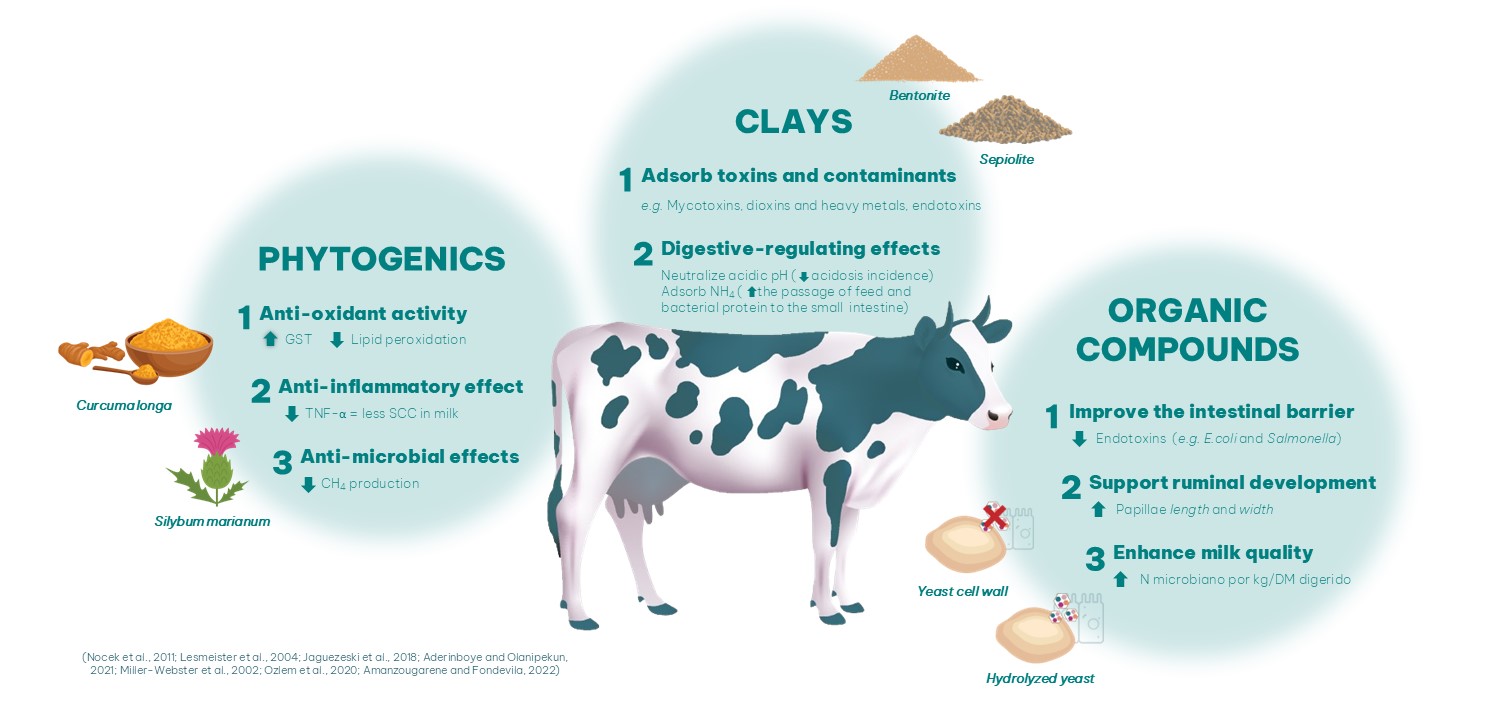Introduction
It is generally thought that ruminants are less prone to develop mycotoxicosis, due to ruminal detoxification processes exerted by their ruminal microbiome. Although ruminal bacteria actively neutralize or detoxify mycotoxins in their less toxic form, these processes are not always effective to counteract mycotoxins detrimental effects.
In fact, it has been reported that numerous factors can play a pivotal role in mycotoxicosis extent. Animal-related factors, such as health status, ruminal pH and microbial activity, lactation stage and intestinal adsorption rate can highly influence the extent of this condition.
Beside the animal status, diet-related factors are probably the most responsible for mycotoxins exposure, in fact, ruminants diet include starch, protein feeds, grazed forage, hay or grass, crop forage maize, cereals and silage, which increase the risk of mycotoxins exposure compared to less varied monogastric diets. Lastly, it should also be considered those factors liked to the environment, as farm management and hygiene practice (Gallo et al., 2015).
The studies that use omics techniques are gaining great interest, since allow to establish a potential correlation between mycotoxins contaminated food and several biochemical parameters. For example, Dong et al. (2004) conducted a study in dairy cows where the imbalance in redox status was highly related with silage contaminated with Fusarium spp., where deoxynivalenol (DON) induced changes in ruminal microbial composition, alteration of unsaturated fatty acids and amino acid synthesis, beside a strong decrease in milk yield.
As showed in table 1, mycotoxins effects can lead to an inefficient herd with severe economic losses. For this reason, while ongoing research is trying to establish cost-effective methods, such as biochemical parameters highly correlated with mycotoxin exposure; one of the most practical implemented solutions, under practical farming conditions, is the inclusion of anti-mycotoxin products in ruminant’s diet.
BIŌNTE offers solutions to counteract mycotoxins effects, thus providing a real support for animals challenged by mycotoxins.

Table 1. Ruminants mycotoxins sensitivity and effects
BIŌNTE® QUIMITŌX® PLUS ALLEVIATES MYCOTOXINS EFFECTS IN DAIRY COWS
BIŌNTE® QUIMITŌX® PLUS is an anti-mycotoxins solution with a triple action that includes adsorption, bioprotection and post-biotic effect. Each component included into the formulation has a specific effect on animal metabolism: clays, natural extracts and a combination of selected yeasts (Figure 1).
To test our anti-mycotoxins agent in dairy cows, an in vitro study was conducted in collaboration with the Università Cattolica del Sacro Cuore, with the main aim to evaluate the ruminal efficacy of BIŌNTE® QUIMITŌX® PLUS to counteract mycotoxins negative effects in lactating dairy cows.
Following the procedure described by Gallo et al., (2010), a rumen fluid was collected from two dairy cows. The mycotoxin groups evaluated in this trial included aflatoxin (AFB1), fumonisins B1 and B2 (FB), deoxynivalenol (DON), T-2 and HT-2 toxins, and zearalenone (ZEN). To assess BIŌNTE® QUIMITŌX® PLUS efficacy, two in vitro doses were tested, based on a constant rumen volume of 50 L under laboratory conditions:
- Dose 1: Simulated 30 mg per cow per day of BIŌNTE® QUIMITŌX® PLUS.
- Dose 2: Simulated 90 mg per cow per day of BIŌNTE® QUIMITŌX® PLUS.

Figure 1. Characteristic of components included into BIŌNTE® QUIMITŌX® PLUS formulation.
The concentration of each mycotoxin, expressed as parts per million (ppm) on a dry matter (DM) basis, is presented in Table 2.

Table 2. Mycotoxin concentration
Each treatment included 3 analytical replicates at each incubation time (1 and 4 hours after incubation), with 2 experimental runs (experimental replicates).
BIŌNTE® QUIMITŌX® PLUS SHOWED HIGH CAPACITY IN ADSORBING MYCOTOXINS IN RUMINAL FLUID OF DAIRY COWS
As showed in Figure 2, BIŌNTE® QUIMITŌX® PLUS demostrated a 100% adsorption efficacy against AFB1 at both dosages, thus minimizing the carry-over of its metabolites (e.g. AFM1) in milk.

Figure 2. Efficacy of BIŌNTE® QUIMITŌX® PLUS on AFB1.
The same result was obtained with T-2 and HT-2 toxins adsorption, thus lowering the risk of metabolic alterations and impaired performance in ruminants (Figure 3).

Figure 3. Efficacy of BIŌNTE® QUIMITŌX® PLUS on T-2 / HT-2 toxins.
Also, BIŌNTE® QUIMITŌX® PLUS showed high efficacy against ZEN, thus minimizing the negative effects of this mycotoxin (e.g. milk losses or infertility) in dairy cows (Figure 4).

Figure 4. Efficacy of BIŌNTE® QUIMITŌX® PLUS on ZEN concentration.
Following with FBs results, BIŌNTE® QUIMITŌX® PLUS demonstrated to rapidly reduce its concentration in ruminal fluid, indicating its potential as a reliable solution for mitigating FBs effects in dairy cows (Figure 5).

Figure 5. Efficacy of BIŌNTE® QUIMITŌX® PLUS on FBs concentration.
BIŌNTE® QUIMITŌX® PLUS demonstrated to be efficient in reducing the concentration of DON in the rumen fluid of dairy cows (Figure 6).

Figure 6. Efficacy of BIŌNTE® QUIMITŌX® PLUS on DON concentration.
These results, published in full version in Toxins, highlight the potential of BIŌNTE® QUIMITŌX® PLUS to alleviate the harmful effects caused by mycotoxins in dairy cows, offering a promising approach to enhance the animal health and productivity by mitigating toxin-related stress and damage.
Conclusions
Mitigating the effects of mycotoxins is essential for maintaining animal health. When elevated levels of mycotoxins are found in ruminant raw material or silage, using a proven mycotoxin binder is strongly recommended. BIŌNTE® QUIMITŌX® PLUS has demonstrated high in vitro efficacy in dairy cows, providing a cost-effective solution, to mitigate mycotoxins effects in this specie.


